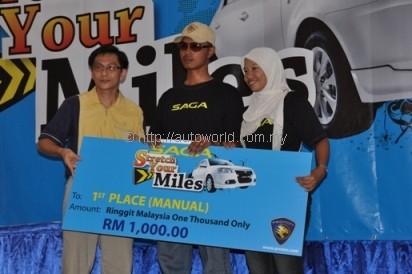37.82 kilometres Per Litre! Incredible Fuel Consumption From Proton Saga 1.3
How do you get 37.82 kilometres from one litre of petrol? This intriguing figure was achieved by a Proton Saga owner in the Saga Stretch Your Miles economy test organized by Proton Edar for its customers on Saturday, 7 November 2009.
The competition was run over 196.50 kilometres of a mixture of highway and trunk roads. Starting from Juru AutoCity, the route took the 30 competitors south on the North-South Highway to the Kuala Kangsar Exit, approximately 100 kilometres away. From there, the cars took to the trunk road, heading back towards Taiping, and rejoined the highway at the Kamunting exit, before heading back towards Juru AutoCity. In addition to the highway and the trunk roads, the competitors had to climb Bukit Berapit on the way out, and again on the way in, via the trunk road, not to mention the fact that there were some traffic light junctions and local traffic to throw some spanners into the equation.
The 37.82 kilometres per litre fuel consumption figure was achieved by En. Megat Zahidi, whose co-driver was Ms. Siti Aminah. En Megat drives a Proton Saga 1.3 maunal transmission, and hails from Kedah, and has never taken part in any such economy test prior to this event. When asked how he managed to achieve this fantastic figure, he attributed it to the tips given by the organizers on how to drive frugally. These included running with the air-conditioner off, driving barefooted to have a better feel of the accelerator, minimising the use of the brakes, very gentle acceleration, and keeping the average speed at around 60 km/h. Other ‘trade secrets’ he employed were coasting in neutral and switching off the engine at traffic lights to save fuel. Over the entire course, Megat used up 5.195 litres of RON 95 fuel, priced at RM1.80 per litre. Translated to sen per kilometre, this works out to be 4.75 sen.
The next nearest competitor, who won second place in the overall standings, was Mohd Syahfuad with Co-driver Muhammad Firdaus, both from Penang. They drove another Proton Saga 1.3 manual, and used 6.030 litres for the entire course. This translates to 32.58 kilometres per litre, or 5.5 sen a kilometre.
In the Proton Saga Automatic Category, the best fuel consumption figure achieved was by Mohd Ariff and M Nazri, in a Selangor registered Proton Saga Automatic, was 7.287 litres, which equates to 26.95 kilometres per litre.
Between the various competitors, the variance in fuel consumption was quite interesting; the worst fuel consumption recorded for the run was 18.707 litres, or 10.5 litres per litre. The entire 30 cars used up 316.83 litres of fuel, and giving an average of 18.6 kilometres per litre.
Would it be possible for one to achieve such fantastic fuel consumption in a Proton Saga on a daily basis? The answer is yes, because it has been achieved in the competition, and the competition was held on typical roads used by motorists. However, you would have to make certain compromises, to maintain a balance between enjoying your drive and going all out for fuel economy. The results obtained above were achieved by 30 teams competing against each other over a four-hour period. Doing exactly what the top ones did on a perpetual basis would be very taxing. Moreover, the results would be totally different if a different road was used, as the road contours would be different, and the traffic conditions would be different. In fact, during the competition itself, some cars were delayed at traffic lights, and some of the unluckier ones got caught in some heavy traffic. All these conditions affect the fuel consumption.
Secondly, if you like to enjoy creature comforts like the air-conditioner, it uses up more fuel. Switching on your headlights at night uses up a little more fuel, as your alternator has to work to recharge your batteries. In your day to day schedules, us busy types would use up a little more fuel, especially in the cities, where we have frequent starts and stops, and heavy acceleration to get away first at the traffic lights. Any heavy-footed acceleration would momentarily increase the rate of fuel consumed, because most of the fuel is just being blown out the exhaust as un-burnt gases.
If you have just serviced your car, it will be more economical; fresh and clean engine oil in your crankcase lessens the load on your engine, and a well-tuned engine consumes less fuel. Even items like proper tyre pressures and correct wheel alignment and well balanced tyres can contribute to improved fuel consumption.
The practical side of it would be to consciously save fuel whenever you can: light and gentle acceleration, keep the engine revolutions low, but be careful not to ‘lug’ or overload the engine, switch off the air-conditioner at night, or when it is cool, switch off the engine if you are planning to stop for more than a minute, etc, etc. In my own experience, I have saved as much as 35 percent on fuel over the same journey to and from a long distance destination just by reducing the average speed, and by staying away from hard acceleration.





























